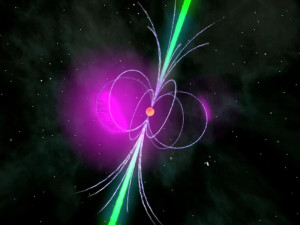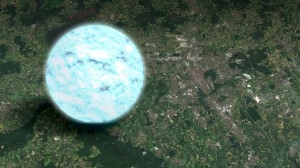
A gamma-ray pulsar is a compact neutron star that accelerates charged particles to speeds that are described only by the theory of relativity in a strong magnetic field. The process produces gamma radiation seen in violet. (NASA/Cruz de Wilde)
A network of 40,000 volunteer researchers, along with 200,000 personal computers worldwide, has helped scientists from the Max Planck Institutes for Gravitational Physics and Radio Astronomy – the Albert Einstein Institute (AEI) discover four gamma-ray pulsars.
Pulsars are compact and rapidly rotating neutron stars which are the remains of stars that have exploded.
The discoveries made by this unique collaboration were made possible by an online computing project called Einstein@Home, which was launched back in 2005 as a joint program from the Center for Gravitation and Cosmology at the University of Wisconsin-Milwaukee and the AEI in Hannover, Germany.
The volunteers were from countries such as Australia, Canada, France, Germany, Japan and the USA, and used data from NASA’s Fermi Gamma-Ray Space Telescope, according to the AEI.
“Our innovative solution for the compute intensive search for gamma-ray pulsars is the combination of particularly efficient methods along with the distributed computing power of Einstein@Home,” said AEI’s Holger Pletsch, who’s also the lead author of the study. “The volunteers from around the world enable us to deal with the huge computational challenge posed by the Fermi data analysis. In this way, they provide an invaluable service to astronomy.”
The online computer project connects 200,000 home and office computers to a global supercomputer. Since identifying these new gamma-ray pulsars requires a lot of computing power, the combined computing ability provided by the Einstein@Home network of personal computers, along with the supercomputer, provides scientists with an efficient yet more cost effective way to conduct their research.

A neutron star is the densest object astronomers can observe directly, crushing half a million times Earth’s mass into a sphere about 20 kilometers across. This illustration compares the size of a neutron star to the area around Hanover, Germany (NASA)
“The first-time discovery of gamma-ray pulsars by Einstein@Home is a milestone – not only for us but also for our project volunteers. It shows that everyone with a computer can contribute to cutting-edge science and make astronomical discoveries,” said Bruce Allen from AEI and the principal investigator of Einstein@Home. “I’m hoping that our enthusiasm will inspire more people to help us with making further discoveries.”
Pulsars have usually been detected by the beam of electromagnetic radiation or radio waves they emit when the signal points toward Earth. But, according to AEI officials, the four pulsars discovered through this collaborative effort are only visible in gamma-rays and not radio waves.
AEI officials said special follow-up observations of all four new pulsar discoveries will be conducted with radio telescopes located at Germany’s Max Planck Institute for Radio Astronomy and the Parkes Observatory in Australia. Scientists hope these observations will confirm that radio waves won’t be detected in the pulsars.
Data gathered by the Fermi Gamma-Ray Space Telescope, which was launched from the Cape Canaveral Air Force Base on June 11, 2008 is also credited with helping scientists to discover thousands of gamma-ray sources that they said had been previously unknown. According to AEI those gamma-ray sources may also include hundreds of yet undiscovered pulsars.





















I have participated in the early SETI program, and now am with this one, looking at SagA and other places. I leave the computer on all night and re-start it in the morning to clear daily registers.
It is all part of good citizenship.